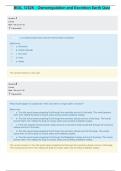Samenvatting
VOLLEDIGE SAMENVATTING 'Organization Theory & Design' - Daft, Murphy & Willmott.
- Instelling
- Tilburg University (UVT)
Volledige samenvatting van alle 14 hoofdstukken van 'Organization Theory & Design' van Richard L. Daft, Jonathan Murphy en Hugh Willmott. Er worden veel tabellen en afbeeldingen gebruikt om de tekst te verduidelijken.
[Meer zien]















